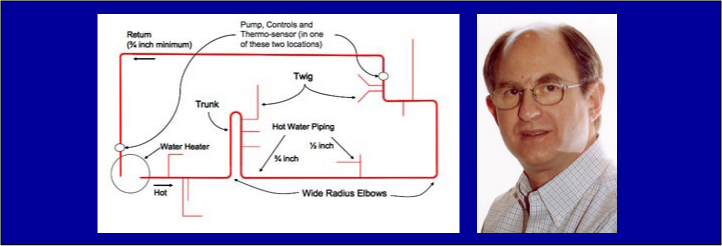
Videos
The International Association of Plumbing and Mechanical Officials filmed Gary Klein's presentation titled "The Future of Space Heating is a Very Efficient Water Heater" at the first International Emerging Technology Symposium in Chicago, Illinois, in August 2008. What follows is his presentation as a series of Youtube clips.
Energy use and equipment installations -- Gary Klein asks the audience how many days they heat and cool, and what percentage of energy use goes to water heating and space heating, then shows pictures of typical installations. 8:22
Current technology and measurement parameters -- Gary points out that housing has become more efficient but water and space heating equipment has not sized down at the same time, so you can't buy small-enough equipment to match it. He also says that part-load is becoming more important than peak-load, but nobody measures part-load. The same issue exists with measuring efficiencies in combi systems. 7:42
The challenges of combi systems -- Linda Wiggington of Affordable Comfort discusses the promise of combi systems to scale with improvements in housing efficiency and the challenge of getting different groups behind them in order to test them and make sure the efficiencies are real and not theoretical. She notes that earlier systems were rife with problems. 9:56
Cross-pollination of ideas -- Linda and Gary are interviewed after their presentation and say that the advantages of speaking is that they meet people different from them with ideas different from theirs. 5:09
"Practical Plumbing Layouts" was presented during the First International Emerging Technology Symposium, August 19-20, 2008, at the O’Hare Marriott in Chicago.
Part 1 -- Gary asks his audience a series of questions about their hot water use, how fast they get hot water, and how fast they'd like to get hot water. 7:25
Part 2 -- Gary lays out the steps involved in a typical shower, explains how hard it is to get quick hot water, explains what people want in hot water, and discusses different types of plumbing delivery systems. 8:50
Part 3 -- Gary defines the challenge: to get hot water in three seconds without wasting more than a cup of water, then commandeers half the audience to help show how pipe diameter and length affects amount of water lost. 9:53
Part 4 -- The next step is to create, with tape and cards on the floor and people, a typical U.S. trunk and branch plumbing layout with the locations of the water heater and fixtures. 9:51
Part 5 -- Gary and his helpers decide what size piping to use to each fixture and where the piping will go, taking into account energy loss issues and ease of maintenance after construction. They also measure how many feet of pipe and calculate volume. 9:19
Part 6 -- The layout shows the difficulty of reaching the one-cup and three-second delivery goal with typical plumbing. Gary explores the advantages and disadvantages of traditional recirculation systems to cut the wait and water loss. 9:45
Part 7 -- Gary discusses time/temperature recircs as opposed to demand pumps and the pros and cons, and introduces manifold plumbing. 9:46
Part 8 -- More about manifold plumbing, which is better in a small house than a big one. Gary concludes trunk and branch is superior in most cases, for saving water and energy, and demand pumps are better still. 9:59
Part 9 -- Gary lays out the options that can achieve the goals: 1) Central core plumbing; 2) one water heater for each fixture; 3) Several water heaters in a bigger home; 4) Heat trace; 5) Using a recirculation loop. And he starts discussing tank heaters vs. tankless. 9:43
Part 10 -- Continuing with gas and electric tank vs. tankless, Gary suggests that tank heaters, especially condensing gas, can have efficiencies higher than tankless. 6:42
Part 11 -- Gary's conclusion is that neither tank or tankless is the solution, but a system that has some tank storage and a powerful heat source. The storage ensures immediate hot water, while the heat source ensures continuousness. Such a system could also be used for space heating. But such a system will work even better with structured, planned plumbing systems and heat pumps. 6:17